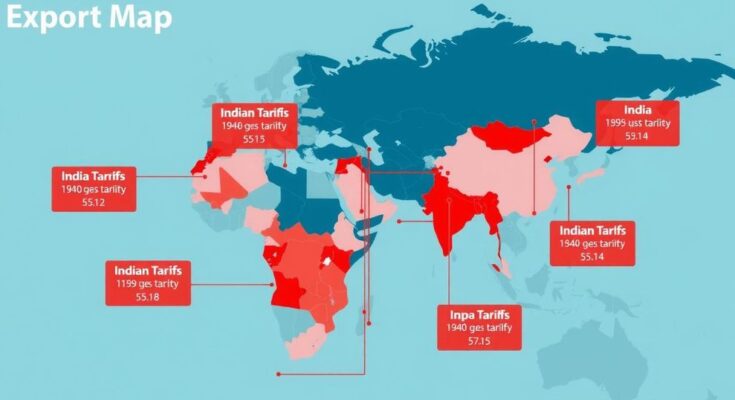In 2023, India faces a 27 percent tariff on exports to the US, impacting various sectors. Although challenges exist, India is better positioned than competitors such as China and Vietnam. Key sectors like textiles may benefit, while automotive exports and agriculture will face hurdles. Ongoing trade negotiations might alleviate some tariff burdens.
In 2023, India emerged as the world’s 12th-largest exporter, achieving total exports valued at $441 billion. However, the introduction of a 27 percent flat tariff on all exports to the United States poses challenges for Indian exporters. Notably, India appears to have a comparative advantage over major competitors like China, Vietnam, Bangladesh, and Indonesia in this context.
China currently bears a 34 percent tariff, while Vietnam faces a significant 46 percent charge. Other competitors such as Bangladesh and Thailand are subject to 37 percent tariffs. Cambodia faces the highest tariff at 49 percent, while Sri Lanka is impacted with a 44 percent charge, which positions India favorably in the global export landscape despite the challenges.
The US has implemented a 25 percent tariff on imported automobiles, which could heavily impact major Asian automakers, including Toyota, Honda, and Nissan. However, India’s exports in this sector are relatively minor, with passenger and commercial vehicles contributing merely 0.13 percent and 3 percent, respectively, to total auto exports. Conversely, Tata Motors may face indirect consequences, particularly through its luxury car brand, Jaguar Land Rover, which derives significant revenue from the US.
Regarding auto components, India exports one-third of its overall industry output valued at $21.2 billion to the US, although this accounts for only 2 percent of the US market. Major competitors such as Mexico, Canada, and China dominate US auto component imports. In 2023, the US constituted less than 0.5 percent of India’s total car exports, while Saudi Arabia, South Africa, and Mexico emerged as primary export destinations.
India’s textile sector may benefit from the new tariff regulations, as its competitors, including Vietnam, Bangladesh, and China, are subjected to higher duties. In terms of US textile imports, China holds a substantial market share at 30 percent, followed by Vietnam at 13 percent and India at 8 percent, which equates to $9.7 billion. Notably, textiles contribute a mere 2 percent to India’s GDP, whereas Bangladesh and Vietnam account for 11 percent and 15 percent, respectively, rendering India less susceptible to sector-specific adverse impacts.
In the gems and jewellery market, India remains a major supplier to the US, contributing approximately 12.99 percent, valued at $11.58 billion. Competing countries, including France, Italy, the UAE, and Thailand, provide significantly smaller shares, strengthening India’s competitive position, even as the tariffs may have a pronounced impact on Indian exporters.
Agricultural exports, particularly Basmati and non-Basmati rice, buffalo meat, and wheat, are directly affected by the new tariff structure. Yet, India may maintain a competitive edge in processed food items such as pickles and spice mixes, despite facing stiffer competition from Mexico, which benefits from tax advantages under the US-Mexico-Canada Agreement (USMCA).
In the electronics sector, India exports products valued at $14 billion to the US. The 27 percent tariff will increase costs; however, India maintains an advantageous position relative to Vietnam and China, bearing higher tariffs at 46 percent and 34 percent, respectively. Despite the tariffs, Mexico benefits from tariff-free access for compliant goods under the USMCA. Ongoing bilateral trade negotiations between India and the US may provide potential relief from these tariffs, fostering competitiveness for Indian exports across various sectors despite the newly imposed barriers.
The introduction of tariffs on Indian exports to the United States presents both challenges and opportunities. India finds itself in a relatively favorable position compared to key competitors, such as China and Vietnam, especially in sectors like textiles and electronics. While certain sectors, including automobiles and agriculture, may experience negative repercussions due to higher tariffs, strategic negotiations and India’s positioning could enhance resilience in the export landscape. The potential for mitigating tariff impacts through trade agreements underscores the need for continued diplomatic engagement.
Original Source: www.business-standard.com




